Tandem Mach Zehnder Directional Coupler Design and Simulation on Silicon Platform for Optical Coherence Tomography Applications
Abstract
1. Introduction
2. Design
2.1. MZDC Parameter Design
2.2. Schematic
2.3. OCT Brief Theory
3. Experiments and Results
4. Discussion
5. Conclusions
Author Contributions
Funding
Acknowledgments
Conflicts of Interest
References
- Drexler, W.E.; Fujimoto, J.G. Optical Coherence Tomography: Technology and Applications; Springer International Publishing AG: Berlin/Heidelberg, Germany, 2015. [Google Scholar]
- Brezinski, M.E. Optical Coherence Tomography: Principles and Applications; Academic Press: Cambridge, MA, USA, 2006. [Google Scholar]
- Pircher, M. Development and Application of Optical Coherence Tomography; MDPI AG 2018- Multidisciplinary Digital Publishing Institute: Basel, Switzerland, 2018. [Google Scholar]
- Yurtsever, G.; Považay, B.; Alex, A.; Zabihian, B.; Drexler, W.; Baets, R. Photonic integrated Mach-Zehnder interferometer with an on-chip reference arm for optical coherence tomography. Biomed. Opt. Express 2014, 5, 1050–1061. [Google Scholar] [CrossRef] [PubMed]
- Eggleston, M.; Pardo, F.; Bolle, C.; Farah, R.; Fontaine, N.K.; Safar, H.; Cappuzzo, M.; Pollock, C.; Bishop, D.; Earnshaw, M. 90dB Sensitivity in a Chip-Scale Swept-Source Optical Coherence Tomography System. In Proceedings of the Conference on Lasers and Electro-Optics, San Jose, CA, USA, 13–18 May 2018. [Google Scholar]
- Akca, B.I.; Nguyen, V.D.; Kalkman, J.; Ismail, N.; Sengo, G.; Sun, F.; Driessen, A.; van Leeuwen, T.G.; Pollnau, M.; Worhoff, K.; et al. Towards spectral-domain optical coherence tomography on a chip. IEEE J. Sel. Top. Quantum Electron. 2012, 18, 1223–1233. [Google Scholar] [CrossRef]
- Moore, E.D.; Mcleod, R.R. Phase-sensitive swept-source interferometry for absolute ranging with application to measurements of group refractive index and thickness. Opt. Express 2011, 19, 8117–8126. [Google Scholar] [CrossRef] [PubMed][Green Version]
- Li, Y.; Henry, C. Silica-based optical integrated circuits. IEE Proc. Optoelectron. 1996, 143, 263–280. [Google Scholar] [CrossRef]
- Huang, W.-P. Coupled-mode theory for optical waveguides: An overview. J. Opt. Soc. Am. A 1994, 11, 963–983. [Google Scholar] [CrossRef]
- Maese-Novo, A.; Halir, R.; Romero-García, S.; Pérez-Galacho, D.; Zavargo-Peche, L.A.; Ortega-Moñux, A.; Molina-Fernández, I.; Wangüemert-Pérez, J.; Cheben, P. Wavelength independent multimode interference coupler. Opt. Express 2013, 21, 7033–7040. [Google Scholar] [CrossRef] [PubMed]
- Lu, Z.; Yun, H.; Wang, Y.; Chen, Z.; Zhang, F.; Jaeger, N.A.F.; Chrostowski, L. Broadband silicon photonic directional coupler using asymmetric-waveguide based phase control. Opt. Express 2014, 23, 3795–3806. [Google Scholar] [CrossRef] [PubMed]
- Akca, B.I.; Považay, B.; Alex, A.; Wörhoff, K.; Ridder, R.M.D.; Drexler, W.; Pollnau, M. Miniature spectrometer and beam splitter for an optical coherence tomography on a silicon chip. Opt. Express 2013, 21, 16648. [Google Scholar] [CrossRef] [PubMed]
- Chen, S.; Shi, Y.; He, S.; Dai, D. Low-loss and broadband 2 × 2 silicon thermo-optic Mach–Zehnder switch with bent directional couplers. Opt. Lett. 2016, 41, 836–839. [Google Scholar] [CrossRef] [PubMed]
- Fu, P.-H.; Tu, Y.-C.; Huang, D.-W. Broadband optical waveguide couplers with arbitrary coupling ratios designed using a genetic algorithm. Opt. Express 2012, 24, 30547–30561. [Google Scholar] [CrossRef]
- Little, B.; Murphy, T. Design rules for maximally flat wavelength-insensitive optical power dividers using Mach-Zehnder structures. IEEE Photonics Technol. Lett. 1997, 9, 1607–1609. [Google Scholar] [CrossRef]
- Hsu, S.-H. Signal power tapped with low polarization dependence and insensitive wavelength on silicon-on-insulator platforms. J. Opt. Soc. Am. B 2010, 27, 941–947. [Google Scholar] [CrossRef]
- Culemann, D.; Knuettel, A.; Voges, E. Integrated optical sensor in glass for optical coherence tomography (OCT). IEEE J. Sel. Top. Quantum Electron. 2000, 6, 730–734. [Google Scholar] [CrossRef]
- Yurtsever, G.; Komorowska, K.; Baets, R. Low dispersion integrated Michelson interferometer on silicon on insulator for optical coherence tomography. Opt. Coherence Tomogr. Coherence Tech. 2011, 5. [Google Scholar] [CrossRef]
- Nguyen, V.D.; Weiss, N.; Beeker, W.; Hoekman, M.; Leinse, A.; Heideman, R.G.; Van Leeuwen, T.G.; Kalkman, J. Integrated-optics-based swept-source optical coherence tomography. Opt. Lett. 2012, 37, 23. [Google Scholar] [CrossRef] [PubMed]
- Akca, B.I.; Doerr, C.R.; Sengo, G.; Wörhoff, K.; Pollnau, M.; Ridder, R.M.D. Broad-spectral-range synchronized flat-top arrayed-waveguide grating applied in a 225-channel cascaded spectrometer. Opt. Express 2012, 20, 18313. [Google Scholar] [CrossRef] [PubMed][Green Version]
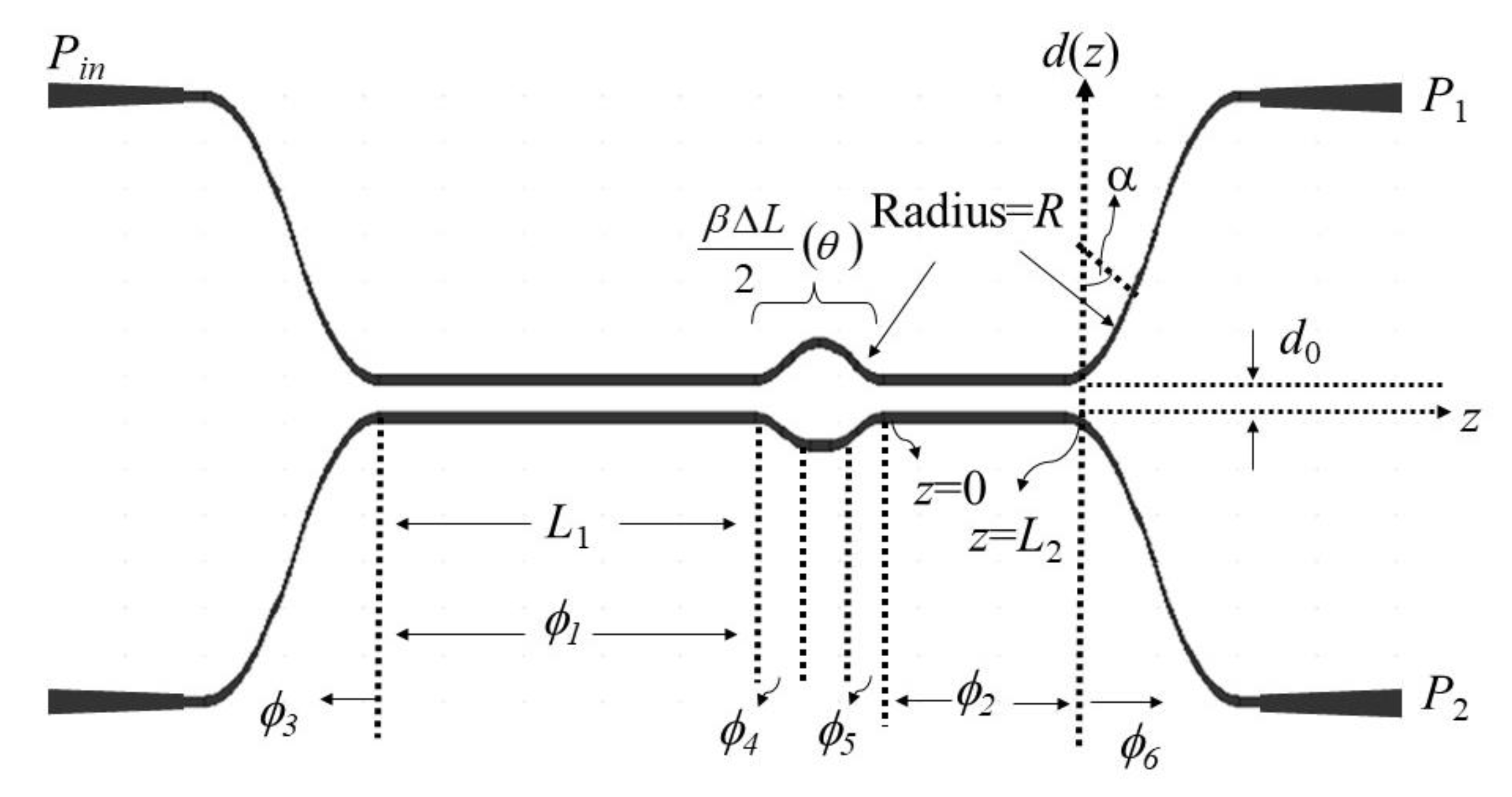
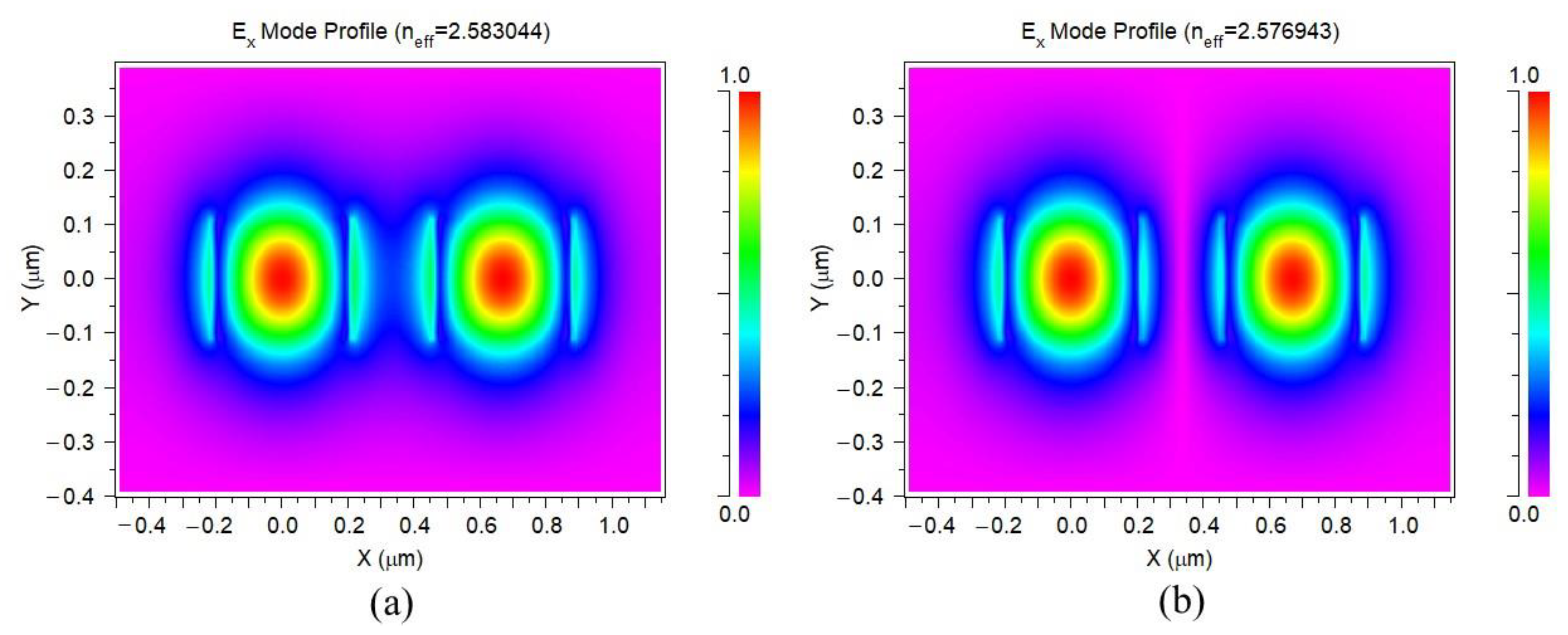



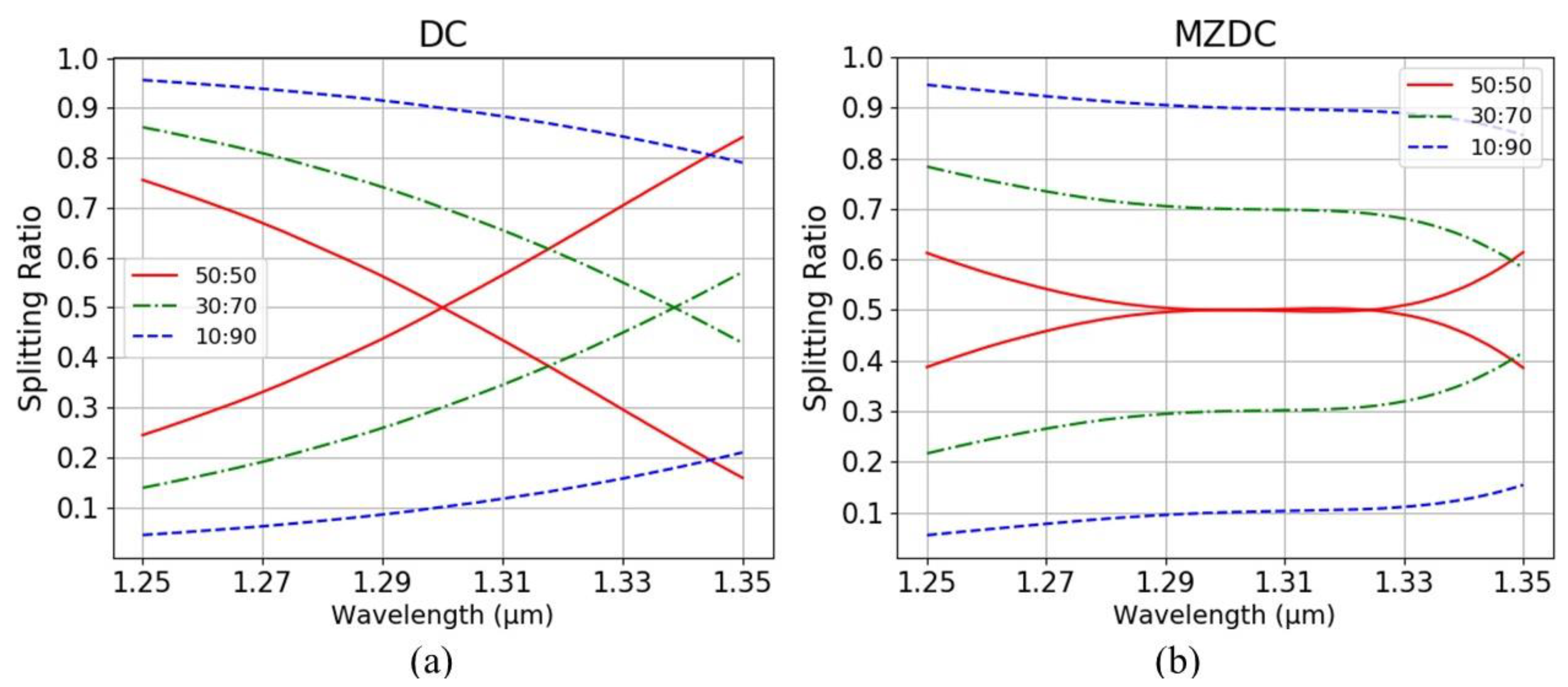
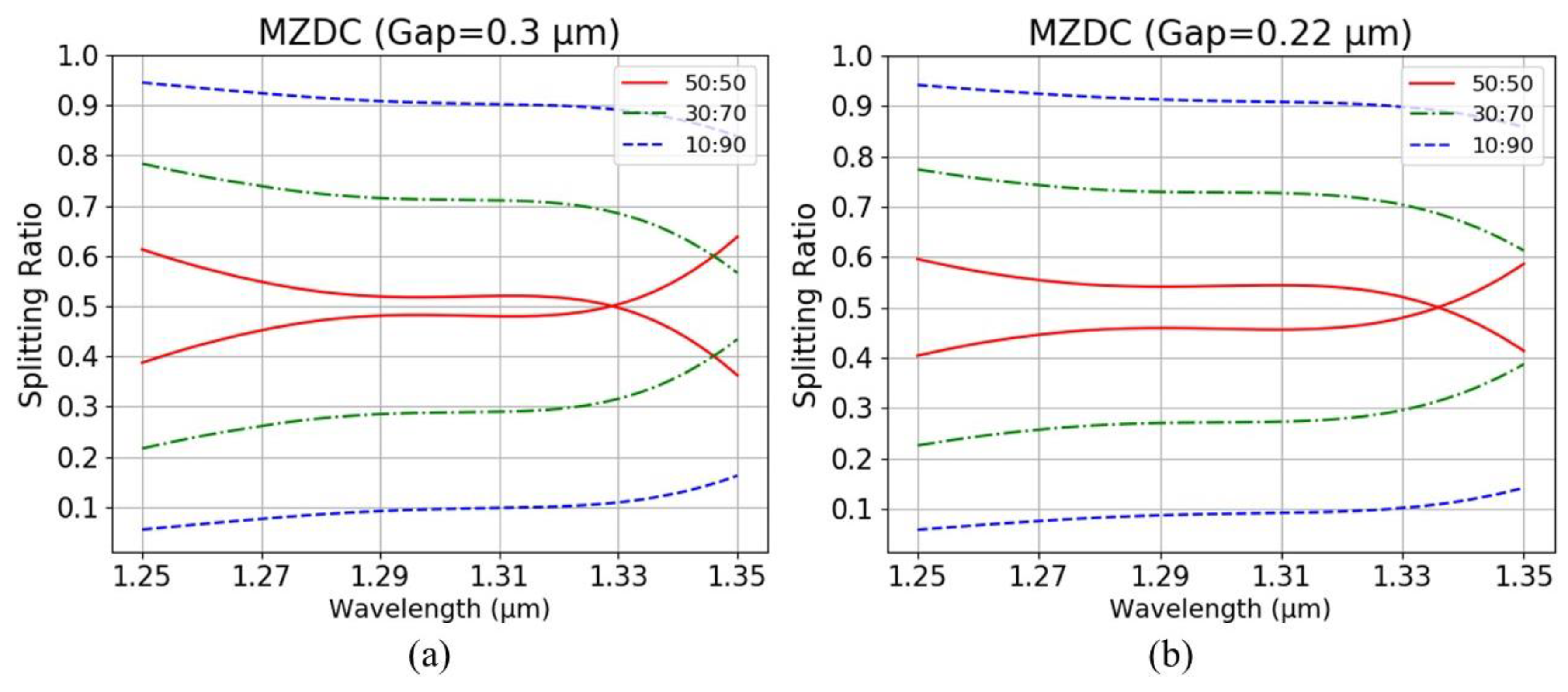
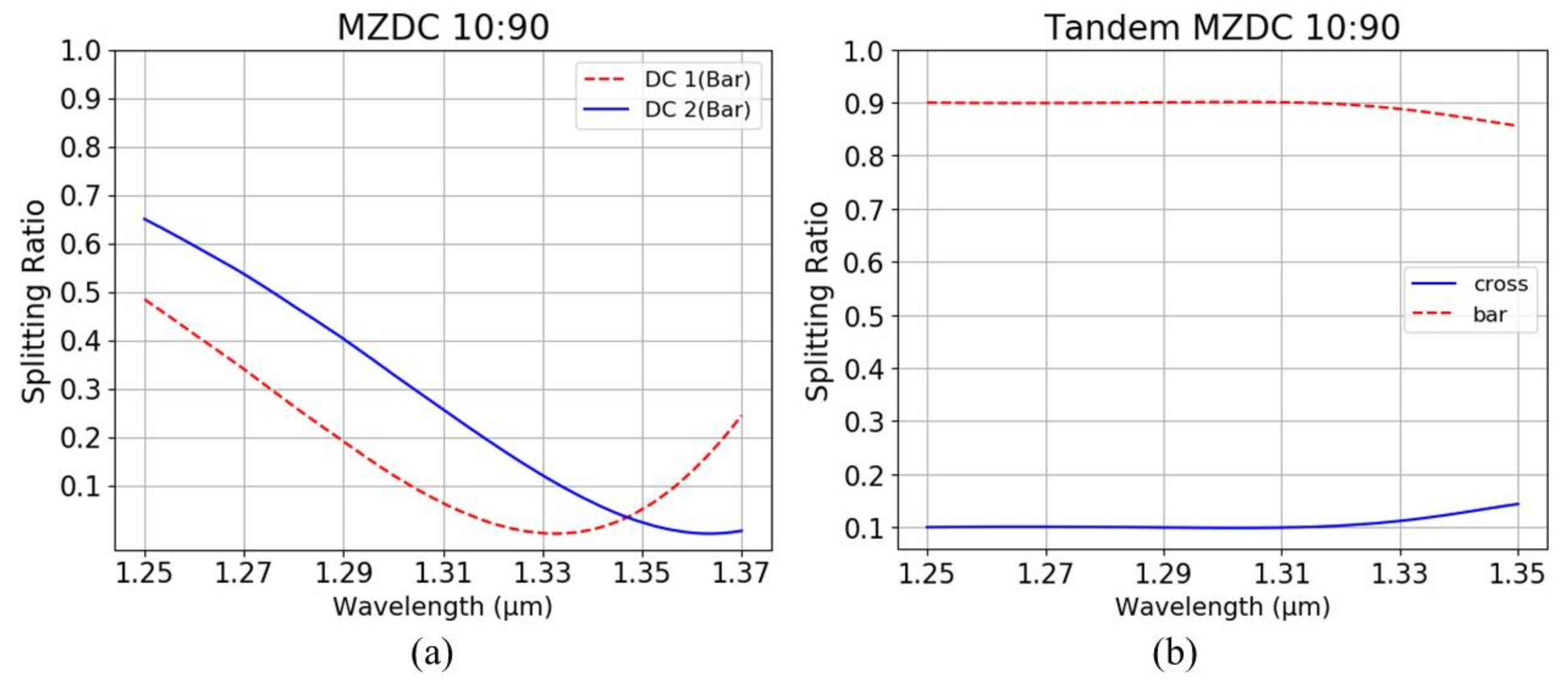
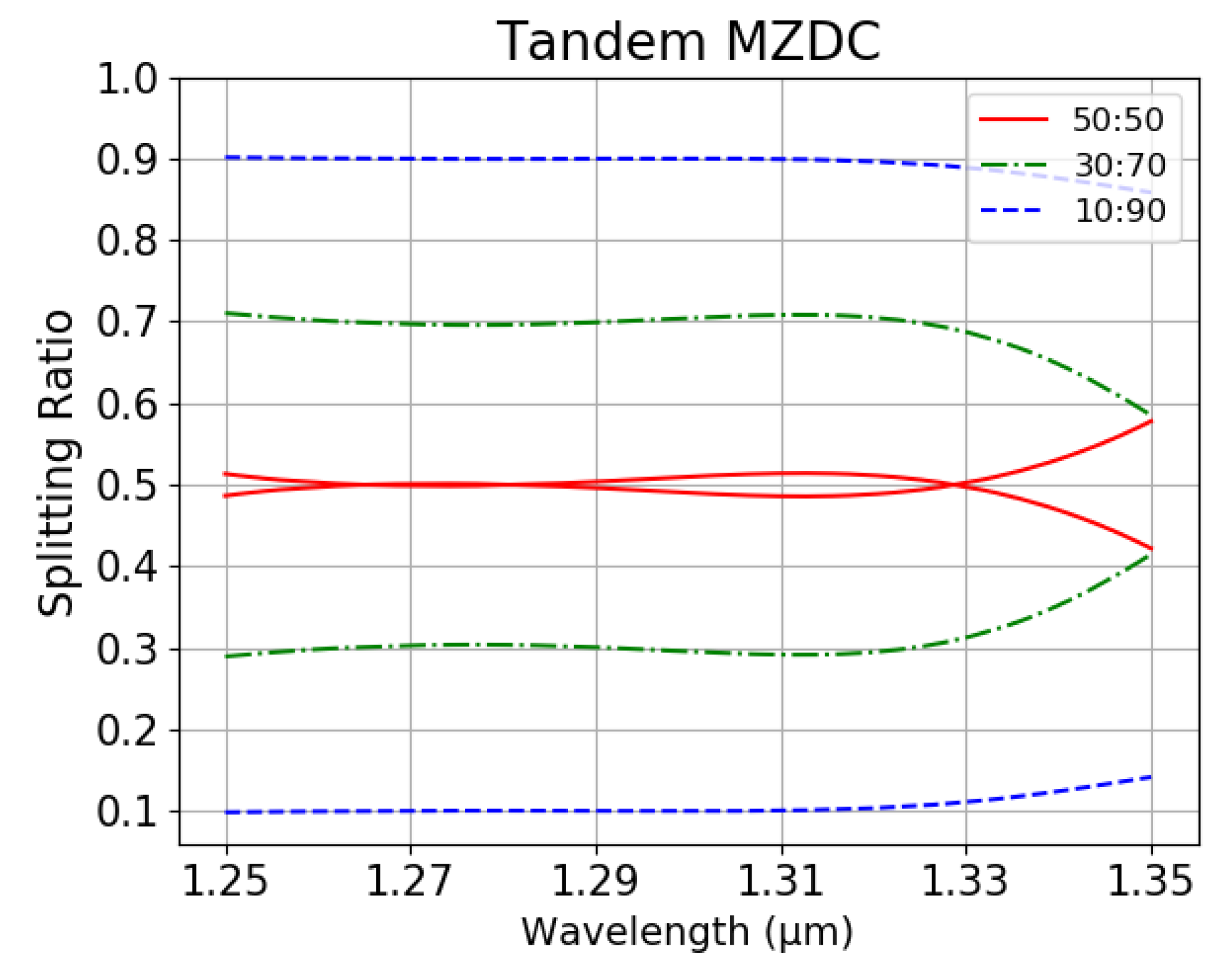
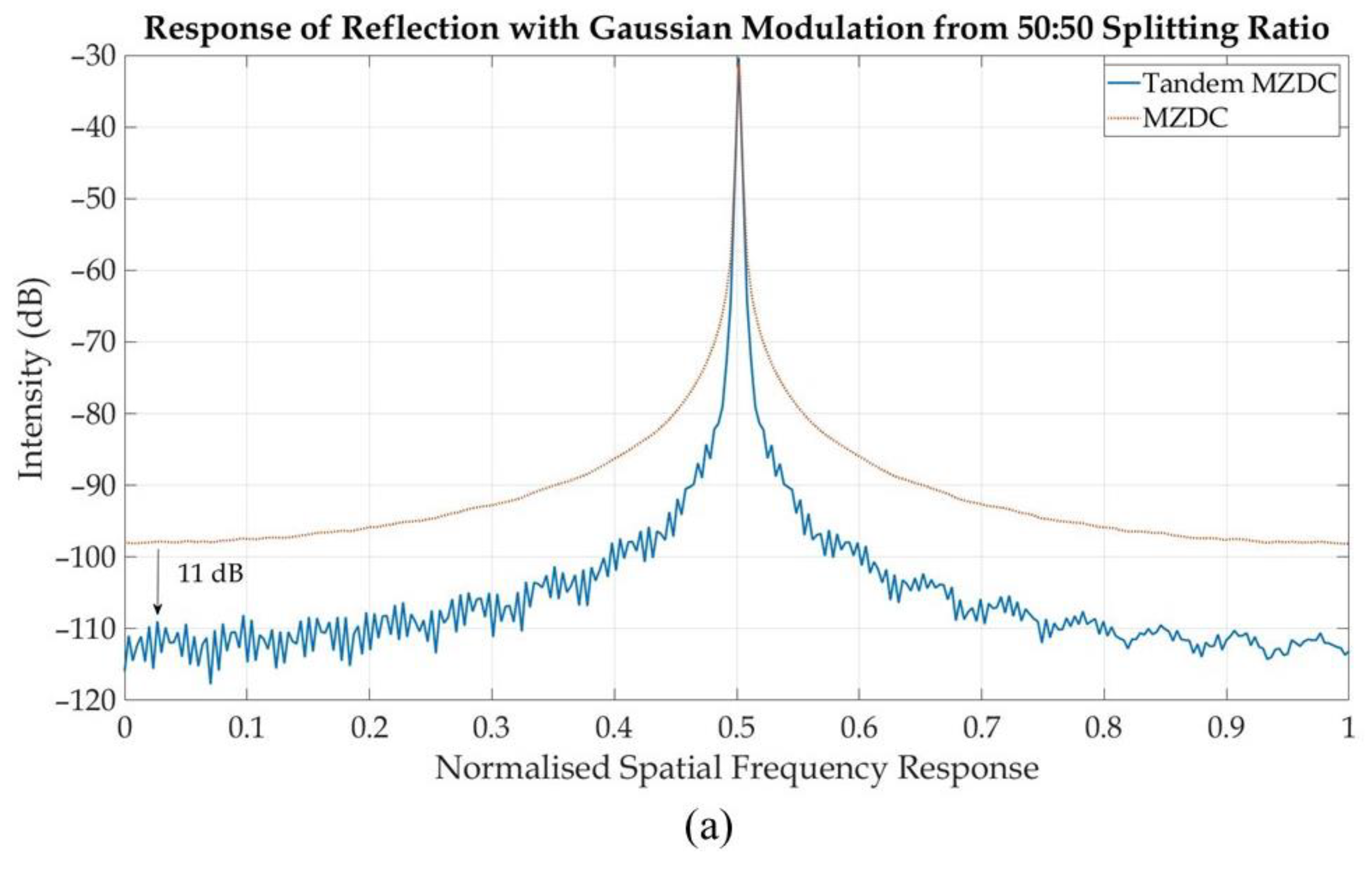
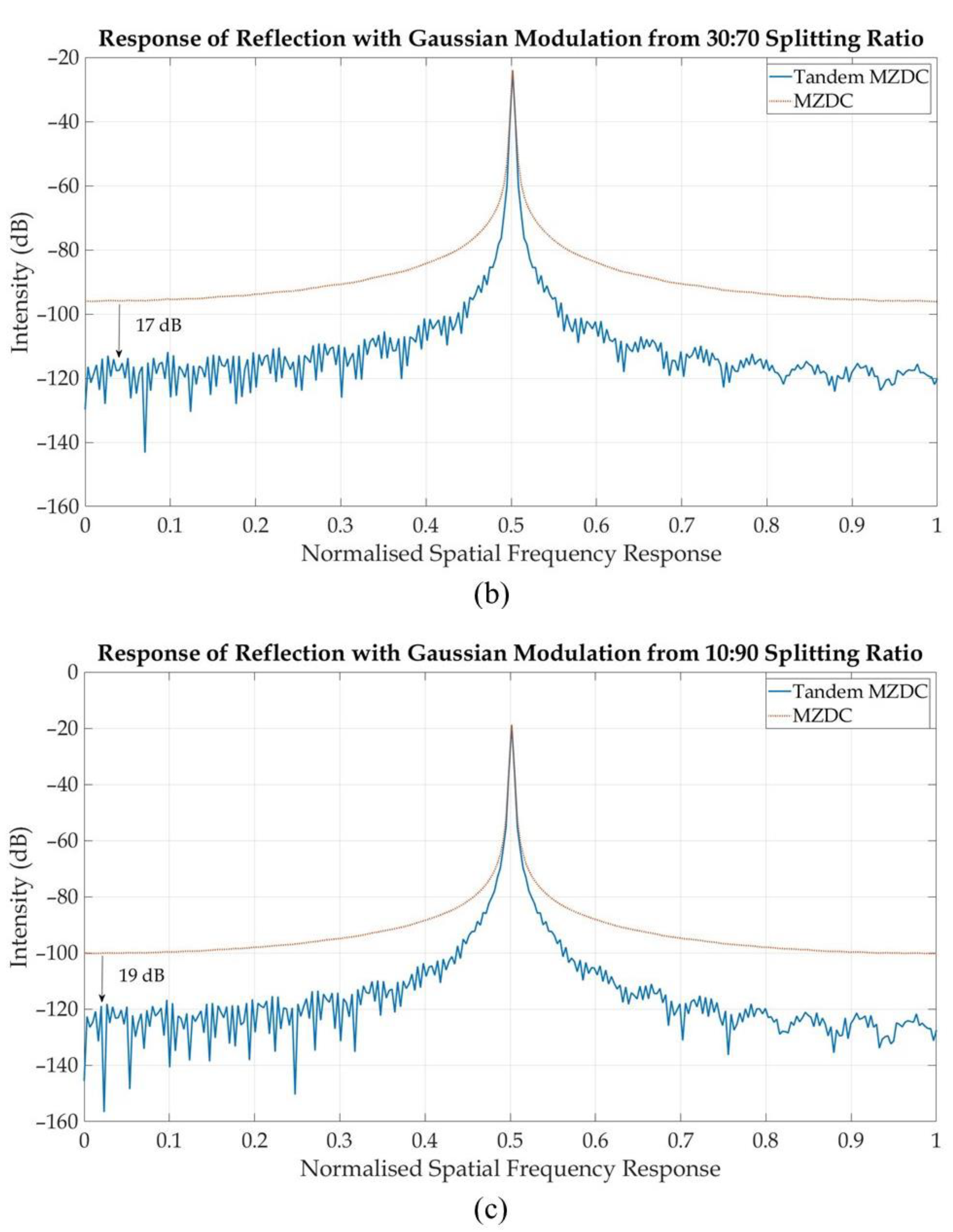
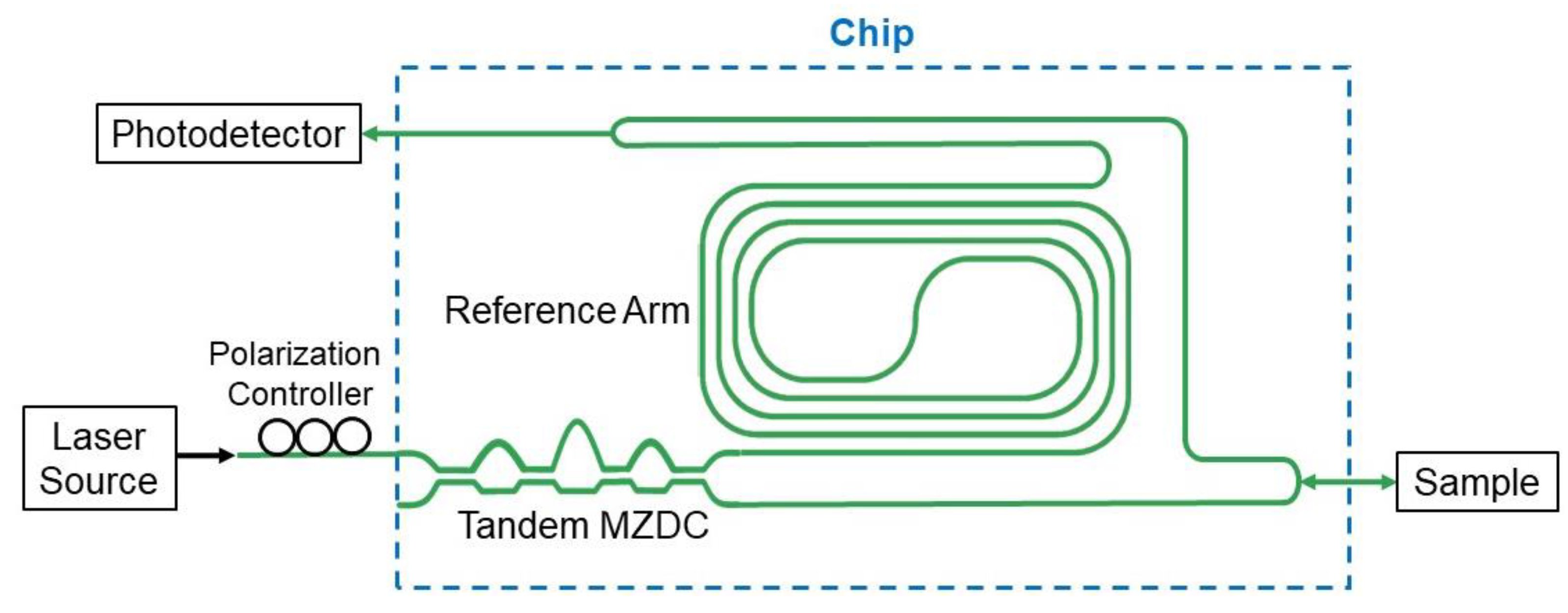
| Splitting Ratio | N | θ (rad) | ||
|---|---|---|---|---|
| 10:90 | 8.485 | 1.317 | 1.039 | 1.327 |
| 30:70 | 4.402 | 1.446 | 0.910 | 1.15 |
| 50:50 | 3 | 1.571 | 0.785 | 1.047 |
| Splitting Ratio | 10:90 | 30:70 | 50:50 |
|---|---|---|---|
| L1 (μm) | 93.77 | 103.22 | 112.39 |
| L2 (μm) | 73.40 | 63.95 | 54.77 |
| (μm) | 0.220 | 0.191 | 0.174 |
| Mean percentage error | 1.64% | 2.87% | 2.99% |
| Splitting Ratio | 10:90 | 30:70 | 50:50 | |
|---|---|---|---|---|
| Including bend part mean percentage error | Gap = 0.3 μm | 1.64% | 2.87% | 2.99% |
| Gap = 0.22 μm | 1.29% | 1.98% | 1.93% | |
| Excluding bend part mean percentage error | Gap = 0.3 μm | 1.75% | 3.37% | 4.01% |
| Gap = 0.22 μm | 1.67% | 3.48% | 4.57% | |
| Splitting Ratio | 10:90 | 30:70 | 50:50 |
|---|---|---|---|
| First MZDC | 06:94 | 02:98 | 0:100 |
| Second MZDC | 25:75 | 63:37 | 50:50 |
| (μm) | 0.52 | 0.55 | 1.49 |
| Mean percentage error | 0.61% | 1.48% | 1.19% |
| Standard Deviation | 0.020 | 0.027 | 0.011 |
| Splitting Ratio | Tandem MZDC SNR (dB) | MZDC SNR (dB) |
|---|---|---|
| 10:90 | 99.42 | 65.45 |
| 30:70 | 84.11 | 58.94 |
| 50:50 | 87.82 | 53.98 |
© 2020 by the authors. Licensee MDPI, Basel, Switzerland. This article is an open access article distributed under the terms and conditions of the Creative Commons Attribution (CC BY) license (http://creativecommons.org/licenses/by/4.0/).
Share and Cite
Lu, Y.-T.; Widhianto, B.Y.B.; Hsu, S.-H.; Chang, C.-C. Tandem Mach Zehnder Directional Coupler Design and Simulation on Silicon Platform for Optical Coherence Tomography Applications. Sensors 2020, 20, 1054. https://doi.org/10.3390/s20041054
Lu Y-T, Widhianto BYB, Hsu S-H, Chang C-C. Tandem Mach Zehnder Directional Coupler Design and Simulation on Silicon Platform for Optical Coherence Tomography Applications. Sensors. 2020; 20(4):1054. https://doi.org/10.3390/s20041054
Chicago/Turabian StyleLu, Yi-Ting, Benedictus Yohanes Bagus Widhianto, Shih-Hsiang Hsu, and Che-Chang Chang. 2020. "Tandem Mach Zehnder Directional Coupler Design and Simulation on Silicon Platform for Optical Coherence Tomography Applications" Sensors 20, no. 4: 1054. https://doi.org/10.3390/s20041054
APA StyleLu, Y.-T., Widhianto, B. Y. B., Hsu, S.-H., & Chang, C.-C. (2020). Tandem Mach Zehnder Directional Coupler Design and Simulation on Silicon Platform for Optical Coherence Tomography Applications. Sensors, 20(4), 1054. https://doi.org/10.3390/s20041054





